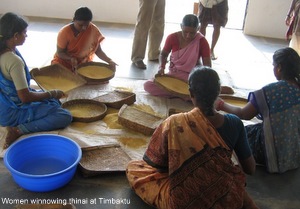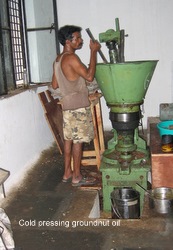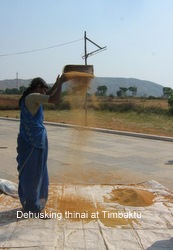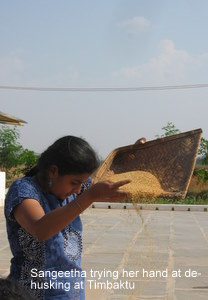
Previous Next Home
Visit to Timbaktu Collective
Visit by members of reStore: Sangeetha,Ananthu, Manasi and Meera (April,2008)
A report by Meera Rammohan
Location: Near the village Chennakottapalli, ½ hr from Dharmavaram, Andhra Pradesh.
Main Contact Persons: Dakshinamurty (Tatchi), Bablu and Mary (Founders) and Dinesh and Kalyani (also core members)
Nature of Organization: An NGO working in the area of forest regeneration, organic farming and revival of millet growing and consumption, school education, women’s empowerment and employment generation (such as through revival of weaving and craft work) for the people living in more than a 100-odd villages in the area.
Our Onward Journey
We took a govt bus from Chennai Koyambedu (7.00 pm) to Dharmavaram (reached about 7.00 am);met by Tatchi (Dakshinamurty) of Timbaktu Collective at the bus stand and then by bus again to Chennakottapalli (CK Palli) (about 30 mins);met by Timbaktu staff and taken by auto to the campus.
The countryside appeared dry, dusty with stony hillocks and few trees. The heat is of a different kind—there is a sense of being parched—no moisture in the air or in the ground. As we reach CK Palli, the woman sitting in the bus next to me points out a shining, aluminium (or metallic) rooftop (somewhat large, floating out of nowhere like a spaceship) as belonging to the 'Timbaktu office'—we find out later that this is the grain storage and processing unit—a large godown area that was constructed about three years ago. 
The campus, living areas and residential school
The campus is more green and cooler than the rest of the area in or around the village.
A few acres have been converted from barren, dry land into the living campus for the permanent members of Timbaktu where they have built about three sets of cottages using sustainable materials with basic comforts and a kitchen-cum-dining area.
The campus contains a few cottages built with pakka materials, simple and small. Dinesh (who comes to meet us) and Kalyani and their son, Prithvi live in one cottage next to our guest cottage while Bablu and Mary (the founders) live in a larger one a little way towards the entrance, next to the kitchen area. The cottage is reasonably cool but no fans are used here. There are two rooms and a simple bathroom with a western loo without a flush! You need to pour water. No running water—water is collected in a large cement (or stone) vessel from a pump outside and carried by bright colourful plastic kodams. We quickly wash, have some tea at the kitchen and meanwhile bump into Bablu and Mary as they go to have their breakfast. Bablu is a big-built, tall and bearded Bengali who appears to have a sense of humour and intellectual all at once!
Dharani Millet Restaurant
As part of the re-introduction and popularizing of millets the Timbaktu collective have built a small thatch-roof structure which serves as a tiny restaurant which can serve about 15 people at a time. There are two cooks both of whom are local women who have been trained by Kalyani (mainly) in making various millet-based recipes. They are really friendly and work with good spirit in such scorching heat! Thinai is the main millet crop grown here and the largest in terms of volume as compared to the other millets.
The Recipes
Most recipes (such as idli, pongal, dosai, pulao etc) are made using thinai as a substitute for rice. They also serve ragi mudde (balls of cooked ragi flour mixed with jowar or bajra flour), which is eaten as a substitute for rice. No coconut chutney is used in this area of Andhra!!instead, since groundnuts are such a widely-grown cash crop groundnut chutney is the common thing. We (all of us from reStore and Tatchi and Dinesh) had breakfast and lunch on both days here. The food is quite tasty and very filling (quite heavy). The only lack (I thought!) was that being a health food restaurant they could offer more vegetable-based dishes and at least good fresh salads which are at present not part of the menu. The women cook inside a small dark little kitchen area with an asbestos sheet on top and they are almost broiled themselves in the process!
The Processing and Packaging Unit
This is a really large structure with a metallic roof that rests on girders and appears like a space ship in the midst of this dry village landscape! They have a really large main internal space divided into three areas. One for packing and storage for which they use plastic covers for the millets and dals etc. For larger grain storage they have ready-made large synthetic drums in different bright colours. They are sealed with tape to make them air-tight. 
They carry out:
- Groundnut Oil Processing
- Groundnut Processing (sorting, cleaning and quality checking)
- Millet (thinai) processing
- Toor dal processing
- Millets such as jowar and bajra are made into flour
Tatchi took us around the unit showing us the way groundnut oil is cold pressed using a machine that is an adaptation of the old-fashioned hand-turned method for expressing oil. We also saw the groundnut sorting unit which helps in sorting of nuts into three different sizes or quality. Dehusking is at present being done by hand, but it is not particularly efficient or cost-effective. Milling of bajra, jowar etc., is also done here using a modified regular flour mill. Ananthu tried his hand at the mill!
Winnowing
Meanwhile, in the outer courtyard area some of the village women were mixing in rich red earth into the toor dal—this was done in large containers and this stirring and soaking in the earth apparently helped to remove the outer husk. We saw also the women sitting around in a circle winnowing and dehusking the thinai—their beautiful rhythmic movements looked simple but they had in place a really efficient technique of removing the bits of husk from front, winnowing the left-over cleaner thinai again and again till it was really free of most of the husk.
 After every such exercise where they took about 20 kg at a time, they take the lot out in the open and pour it out one corner of the muram from about shoulder height at just one particular angle. The breeze does the rest of the work; the softer husk gets blown away while the cleaned thinai seeds are left behind! You can see the photo of Sangeetha trying out this fascinatingly skilled task. This process gets repeated for every lot of thinai three times till it is indeed thoroughly cleaned and dehusked. Timbaktu Collective has specialized and fine-tuned this process so much so they are able to process large quantities of thinai by this traditional but labour-intensive method.
After every such exercise where they took about 20 kg at a time, they take the lot out in the open and pour it out one corner of the muram from about shoulder height at just one particular angle. The breeze does the rest of the work; the softer husk gets blown away while the cleaned thinai seeds are left behind! You can see the photo of Sangeetha trying out this fascinatingly skilled task. This process gets repeated for every lot of thinai three times till it is indeed thoroughly cleaned and dehusked. Timbaktu Collective has specialized and fine-tuned this process so much so they are able to process large quantities of thinai by this traditional but labour-intensive method.
Once processing is done, these cleaned grains, flours, groundnuts etc., are placed in the large storage drums and sealed tight for later distribution to various places.
Discussions about millet storage
We had an extensive conversation with Tatchi regarding the methods of millet processing and storage adopted by Timbaktu. The soil around this area had been badly denuded due to monocropping, application of chemicals. For an acre of land they are able to harvest only 10 to 15 bags of groundnuts.
Tatchi explained to us about the initiative taken by the Women’s Federation in setting up the processing unit and also starting the organic movement among six villages with 120 farmers taking part. The farmers began forming sanghas or groups and now a total of about 415 farmers belong to the movement.
Certification Issues
The concern about certification was also discussed. Tatchi told us about the examples of Brazil, New Zealand and so forth which have begun the concept of a community-based certification system. There is an attempt to evolve an internationally accepted set of norms for certifying of organic produce. Third party certifying is not of much use—what is more important is working with trust regarding the honesty of the farmer. There have been cases of returned goods being found to contain pesticide residue even after certification. Regional councils can oversee the functioning of local farmer groups who would have together undertaken a pledge. The quality of produce thus becomes a collective responsibility.
Visit to a Farmer’s Meet
That evening Dinesh arranged a trip to a village about 35 km away where a farmer’s meet was to take place. These farmer groups around Timbaktu had converted to millet farming with the support and initiative of Timbaktu collective. The sanghas gathered together once in every month or so—these were community events which served as bonding and morale building opportunities for these poor farmers of the area; they discussed their problems and the staff of Timbaktu such as Dinesh spent much time offering encouragement and education regarding millet farming techniques, nutrition and health, lifestyle changes and so on and so forth.
This meeting went on for over three hours with the farmers also singing some of their traditional songs and spending time introducing themselves to us; similarly Dinesh asked each of us to talk about ourselves and about our involvement with reStore, our motivations for doing this work etc., since he felt it would be of moral support to them.
We went back to our guest cottages well past 10.30 p.m. at night by jeep. I could only think of the shyness of the village women, who attended the meeting, but who sat silently towards the back rows away from the men—the young girls seemed to be enjoying themselves and the little kids were grinning, but it was the faces of the weather-beaten old women, who sat upright and stoic that came to me in my dreams that night.
Previous Next Home



